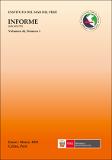Por favor, use este identificador para citar o enlazar este ítem:
https://hdl.handle.net/20.500.12958/3335Registro completo de metadatos
| Campo DC | Valor | Lengua/Idioma |
|---|---|---|
| dc.contributor.author | Tejada Cáceres, Alex | - |
| dc.contributor.author | Baldarrago, Danny | - |
| dc.contributor.author | Gamarra, Alex | - |
| dc.contributor.editor | Instituto del Mar del Perú | - |
| dc.date | 2019 | - |
| dc.date.accessioned | 2019-06-17T18:18:42Z | - |
| dc.date.available | 2019-06-17T18:18:42Z | - |
| dc.date.issued | 2019 | - |
| dc.identifier.citation | Inf Inst Mar Perú 46(1), 2019, p. 45-51 | es_ES |
| dc.identifier.isbn | 0378-7702 | - |
| dc.identifier.uri | https://hdl.handle.net/20.500.12958/3335 | - |
| dc.description.abstract | Se realizó la evaluación poblacional del recurso Lessonia nigrescens “aracanto negro” entre las localidades Yerbabuena y Pocoma, ubicadas en el litoral de la provincia de Ilo, Región Moquegua, entre el 29 de setiembre y 1 de octubre del 2015. El recurso presentó densidad de 8,2 ind/m2 y biomasa media de 17,0 kg/m2, calculándose la biomasa poblacional de 1.046 t (+14,0%) y una fracción adulta de 501 t. La población estuvo conformada por ejemplares con diámetro mayor del rizoide (DMR) entre 3 y 35 cm, moda principal en 12 cm; la longitud total varió entre 23 y 292 cm, estimándose una longitud total promedio de 79,9 cm. El 53,9% de la población tenía estructuras reproductivas en sus frondas. Las condiciones ambientales fueron cálidas, registrándose variaciones de temperatura entre 16,8 y 19,9 °C, con anomalías positivas entre 1,8 y 4,9 °C. | es_ES |
| dc.description.abstract | ABSTRACT: Between September 29 and October 1, 2015, a population assessment was conducted on the Lessonia nigrescens, between Yerbabuena and Pocoma, which are located on the coast of the province of Ilo, Moquegua Region. The resource had a density of 8.2 ind/m2 and a mean biomass of 17.0 kg/m2, resulting in a population biomass of 1,046 t (+14.0%) and an adult fraction of 501 t. The population consisted of specimens with a major diameter of the rhizoid (MDR) between 3 and 35 cm, main mode in 12 cm. The total length varied between 23 and 292 cm, with an estimated mean total length of 79.9 cm. 53.9% of the population had reproductive structures on their fronds. The environmental conditions were warm, showing fluctuations in temperature between 16.8 and 19.9 °C, with positive anomalies between 1.8 and 4.9 °C. | - |
| dc.language.iso | spa | es_ES |
| dc.publisher | Instituto del Mar del Perú | es_ES |
| dc.rights | info:eu-repo/semantics/openAccess | es_ES |
| dc.rights.uri | https://creativecommons.org/licenses/by/4.0/ | es_ES |
| dc.source | Instituto del Mar del Perú - IMARPE | es_ES |
| dc.source.uri | Repositorio Digital IMARPE | es_ES |
| dc.subject | Lessonia nigrescens | es_ES |
| dc.subject | evaluación | es_ES |
| dc.subject | biomasa | es_ES |
| dc.title | Evaluación del recurso Lessonia nigrescens Bory de Saint-Vincent, 1826 entre Yerbabuena y Pocoma, Región Moquegua, setiembre – octubre 2015 | es_ES |
| dc.title.alternative | Assessment of Lessonia nigrescens Bory de Saint-Vincent, 1826 between Yerbabuena and Pocoma, Moquegua Region, September - October 2015. | es_ES |
| dc.type | info:eu-repo/semantics/article | es_ES |
| Aparece en las colecciones: | Informe vol. 46(1) 2019 | |
Ficheros en este ítem:
| Fichero | Descripción | Tamaño | Formato | |
|---|---|---|---|---|
| Informe 46-1 Evaluación del recurso Lessonia nigrescens.pdf | 1,54 MB | Adobe PDF |  Visualizar/Abrir |
Este ítem está sujeto a una licencia Creative Commons Licencia Creative Commons

